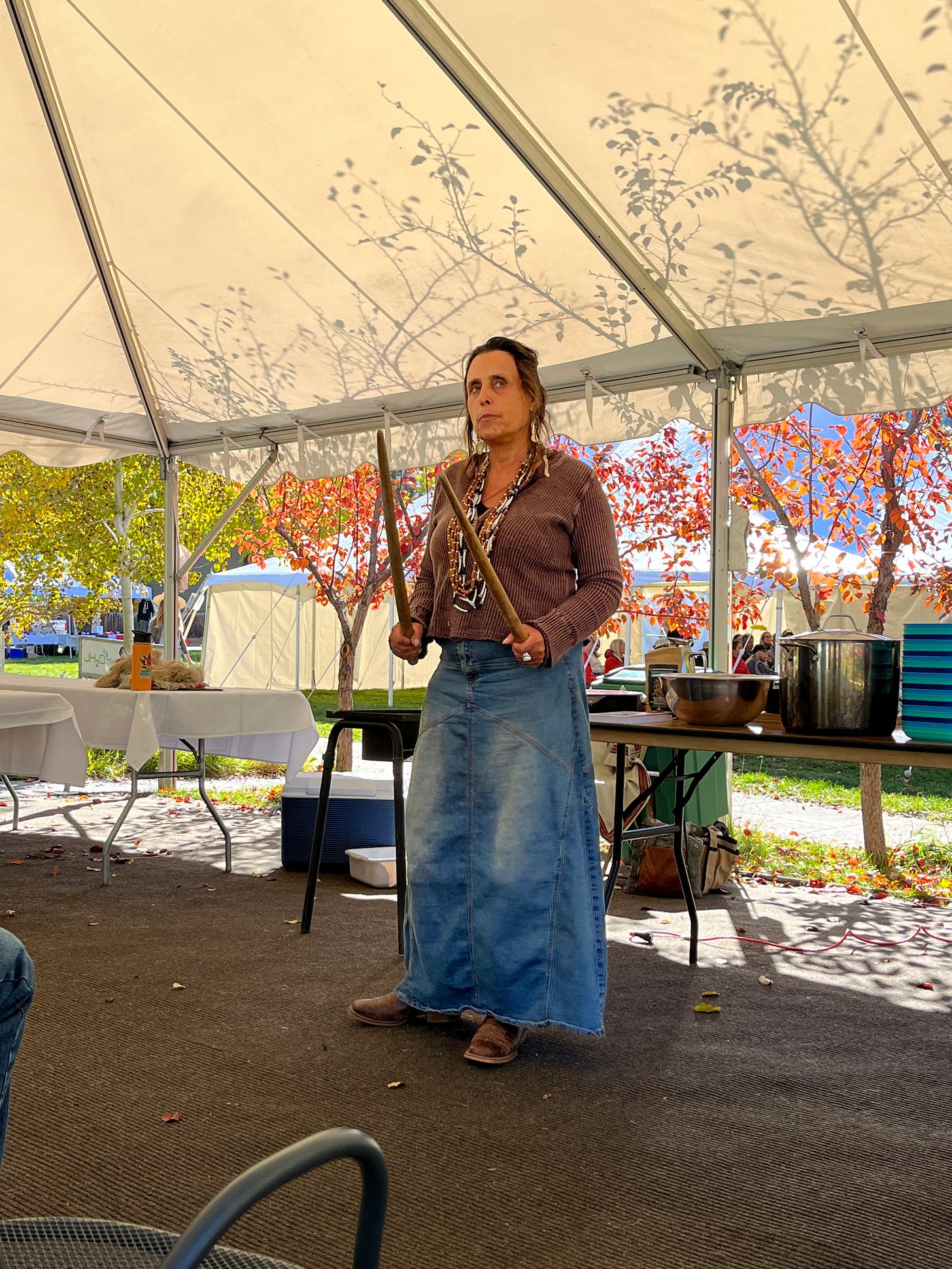A Wild Rice Prophecy
Fulfilled at the Annual Harvest
Winona LaDuke grasped two tapered cedar threshing sticks, called bawa'iganaakoog in the Ojibwe language, and demonstrated how they are used to knock the ripe seed heads while sliding through the tall grass in a canoe. Even without two clubs in her hands, LaDuke has a presence as she addresses her audience in Jackson, Wyoming at the Slow Food in the Tetons Farm to Fork festival on a sunny early October Saturday.
Winona LaDuke is a Native American activist, author, economist, and environmentalist, and one of the most visible Native women in America. She has been in the limelight since she helped form the Indigenous Women’s Network in 1985 and then the White Earth Land Recovery Project in 1989 to buy back lands in the White Earth reservation from non-Natives and create enterprises for the tribal members. In 1993 she helped found Honor the Earth, which supports Native environmental issues and works to build financial resources to help sustain Native communities. She ran for vice president on the Green Party ticket with Ralph Nader in 1996 and 2000. Pipeline protests to protect the lakes and rivers of upper Minnesota from oil companies are her battlefield today and she has succeeded so far.
Her workshop entitled “Foods of Prophecy” described the revelations that urged her Anishinaabe ancestors to migrate to the “land where food grows on the water” prior to European colonialism that displaced the Native population. Northeastern Woodland tribes, the Anishinaabe included the Ojibwe, Odawa, Potawatomi, Mississaugas, Nipissing, and Algonquin peoples who moved west and settled in the Great Lakes where they harvested manoomin, or wild rice. This seed is abundant in the area and is considered a sacred food and a staple of the Native diet. La Duke started a Native enterprise to harvest wild rice and make it available for sale through Native Harvest, a store and online market for Native food products, crafts, clothing, and jewelry.
Another enterprise that LaDuke initiated and oversees is a 40-acre industrial hemp farm on the White Earth Reservation. A wild tangle of hemp, as well as a chic Patagonia bag made from her product, passed through the audience.
Most of the workshop time centered on the preparation and sampling of a large bag of wild rice that LaDuke’s sons harvested for the workshop. The rice was cooked on stage by helpers who also prepared some ground buffalo and vegetables to accompany the centerpiece. Wild rice is a seed, not a grain, so it is high in protein and fiber and a rich source of manganese and ALA, Alpha Lipoic Acid, which may be beneficial for people with Type 2 diabetes because it shows promise in helping the body produce insulin according to some studies.
Learning about the gathering of the seed, the parching in large iron kettles, dancing lightly on the rice in special moccasins to separate the outer covering from the seed, and the winnowing of the chaff gave us all a new appreciation for manoomin. LaDuke interrupted the cooking of the rice at one point, lifted the large pot, carried it over to the closest tree, and poured some of the water on the tree’s roots. This prudent woman didn’t waste a drop of the resource! It went back to the earth, with respect. The audience sampled the finished rice and buffalo dish and marveled at the toothsome chewiness and rich flavor. New converts lined up at the table to purchase bags of rice and LaDuke’s latest book, To Be a Water Protector
Thank you, Winona—now we know. For the record, the term “Indian Summer” is not offensive to Native people, at least not to LaDuke, though the term “Indian giver” is, considering that it more aptly describes the actions of the white settlers in terms of land negotiations with the Natives.
Wild Rice Pilaf
Adapted from Sean Sherman and Beth Dooley’s The Sioux Chef’s Indigenous Kitchen and prepared with what I had on hand.
2 tablespoons neutral oil like sunflower or grapeseed oil
1 pound assorted mushrooms, wild and tame
1 tablespoon chopped fresh sage
½ cup minced shallots
½ cup vegetable stock
4-5 cups cooked wild from one cup of uncooked wild rice
½ cup dried cherries or cranberries
1 cup toasted pecans or roasted chestnuts
1 tablespoon maple syrup to taste
½ to 1 teaspoon smoked Maldon salt
Sage sprig, optional garnish
Heat the oil in a Dutch oven and sauté the mushrooms, sage and shallots. Cook until the mushrooms and shallots are browned and soft. Add the stock, the cooked wild rice and the cherries and cook until the liquid is gone. Stir in the pecans and season with maple syrup and smoked salt to taste. Garnish with a sprig of sage.
To Cook Wild Rice
1 cup wild rice
4 cups water
Salt to taste
Rinse the wild rice thoroughly under cold running water until the water runs clear. Combine the rinsed rice, the water, and the salt in a heavy pot and bring to a boil. Reduce the heat and allow the rice to cook over a low temperature for 45-60 minutes.










So interesting, didn't know wild rice is a seed not a grain! Wow, Ms.Winona is a force!! What a gem. Thanks Anne, as ever!